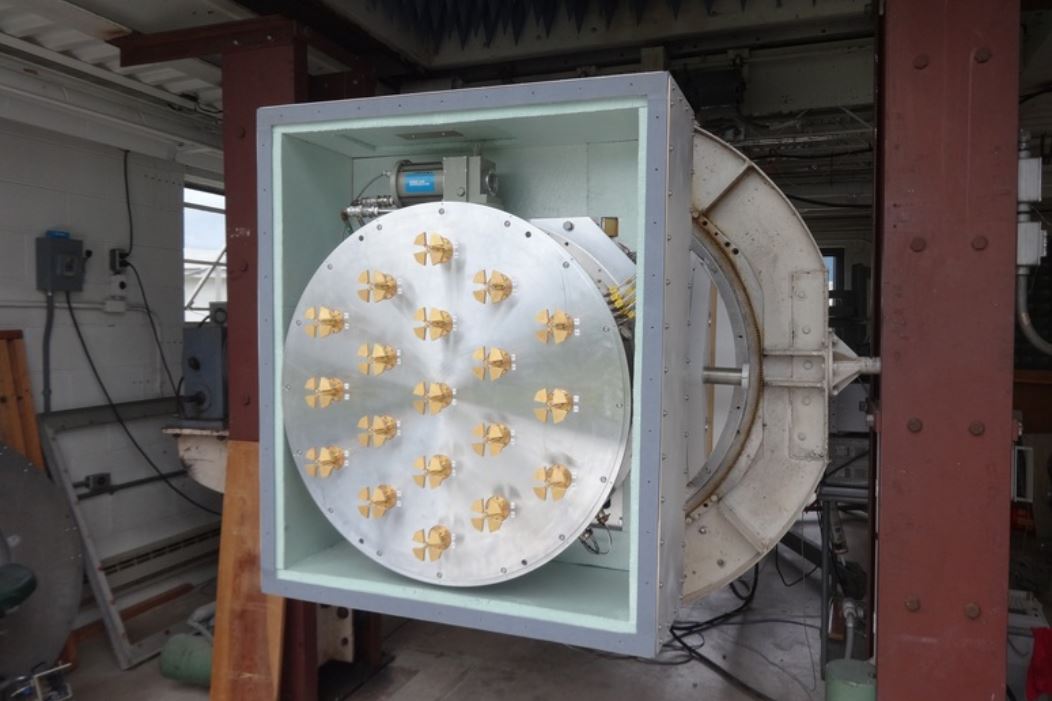New radio camera at Green Bank is first of its kind[8:48 PM]
WVU Today
A critical advancement for astrophysics research led by a team of West Virginia University physics and astronomy students will allow astronomers to be seven times faster in mapping a galaxy. The new radio camera at the Green Bank Telescope is the first of its kind in the U.S.
“This receiver turned out to be as sensitive as the existing receiver on the telescope except we can collect data at seven independent positions simultaneously with the new camera instead of just one,” said Chair and Professor of Physics and Astronomy D.J. Pisano, who studies how galaxies form and evolve. “Only three of these cameras are currently operational in the world, but the Green Bank Telescope’s camera is the most sensitive of its kind.”
The camera, called a phased array feed, contains 19 cross-shaped antennas called dipoles that, while packed closely together, are precisely placed to efficiently capture signals from space. However, it works differently than a digital camera or the cameras found in cell phones. Together, the antennas operate as a large viewfinder, increasing the amount of sky that can be surveyed in a single snapshot. After the signals are captured, it forms the pixels electronically using special software.
“Traditional radio telescopes throughout the world record the information from incoming radio waves using a single detector. This restricts the amount of the sky that can be observed at any given time to a very tiny fraction. This is what is known as the field of view,” said WVU alumnus Nickolas Pingel (Ph.D. Physics, ‘17), one of the original student researchers. “If an astronomer is interested in observing an object that extends beyond a telescope’s inherent field of view, such as a portion of our own Milky Way, they must move the telescope in a complicated manner that takes up precious telescope time.”
The larger the field of view, the quicker a telescope can map the sky.
“Phased array feeds measure the incoming radio waves through not just one but many identical detectors,” Pingel said. “By looking and tweaking how these detecting elements respond to the incoming signals simultaneously, we are greatly expanding the Green Bank Telescope’s field of view. This allows astronomers to work at unprecedented speeds.”
WVU collaborated with researchers at Brigham Young University, the National Radio Astronomy Observatory and the Green Bank Observatory to make this upgrade a reality. WVU’s student team developed the software to translate the signals captured by the camera.
“Our part was all about the computing on the back end. The signal comes from the receiver at the Green Bank Telescope, is digitized and sent down a mile of fiber optics to get to the lab at the Green Bank Observatory where it is fed into high-performance computers,” said Pisano, who will use the camera to map hydrogen gas in galaxies. “Our students were responsible for writing the software that took the signals from those computers and converted them into something you can analyze. They took the raw data and put it all together in a sensible way so it could be useful.”
Pingel created the software that processes the raw data from the camera to produce maps of galaxies.
“The chance to step into such a critical role in the development of a new radio camera, while a bit overwhelming at first, was too good to pass up,” Pingel said. “This project taught me about good coding practices, how to communicate and work within a collaboration and see firsthand how a project evolves from initial brainstorming sessions to sitting on top of one of the world’s largest radio telescopes. I also became a lot more comfortable working through unforeseen problems in high-pressure environments, especially when things went wrong in testing when the camera was on the telescope.”
Today, Pingel is a postdoctoral fellow at the Australian National University. He works on the Australian Square Kilometer Array Pathfinder, one of the other radio telescopes in the world that is consistently equipped with phased array feed technology. He spent his first year as a postdoc writing and developing code that runs on Australia’s most powerful supercomputers to convert raw data into maps.
“This technology optimizes the telescope for survey science by expanding the typical field of view almost 3,000 percent,” Pingel said. “I work on the Galactic ASKAP Survey, which uses the telescope to map hydrogen within our own Milky Way and the nearby Magellanic System at unprecedented resolutions.”
The Green Bank Telescope’s new phased array feed can also be used to look for fast radio bursts, pulsars and other astronomical phenomena at speeds two to three times faster than the telescope’s previous instrumentation. Working with Pingel and current WVU physics doctoral student Devansh Argawal, alumnus Kaustubh Rajwade (Ph.D. Physics, ‘17) led the effort to develop software to translate that data.
Researchers interested in using the new camera can submit a proposal to Pisano or Lorimer.
This project was funded by a $500,000 award from the National Science Foundation Division of Astronomical Sciences Advanced Technologies and Instrumentation Program.




